E Guitar Chord | How To Play The E7 Dominant Chord
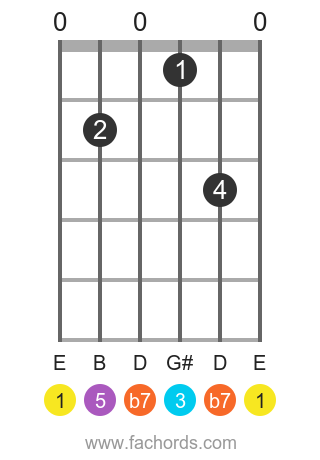
Welcome to our tutorial on the E 7 chord, an essential member of the Dominant Chords family. Composed of the notes E, G#, B, and D, this chord is built on a series of specific intervals: the 1 (Root), 3 (Major Third), 5 (Perfect Fifth), and b7 (Minor Seventh). Understanding these intervals is key to mastering the E 7 chord and its unique sound.
For a deeper dive into the nature and structure of these intervals, you may want to check out our tutorial about fretboard intervals. This guide will provide you with a comprehensive understanding of how these intervals interact to create the distinctive sound of the E 7 chord.
Our tutorial about dominant (7) guitar chords is another fantastic resource for those looking to master the E 7 chord. This tutorial focuses specifically on the family of chords to which the E 7 belongs, offering a broader context for your practice.
Finally, if you're interested in how these chords can be constructed by stacking intervals, our tutorial that teaches how to build chords by stacking intervals is an invaluable tool. It offers a step-by-step guide to understanding and applying music theory to your guitar playing.
Whether you're a beginner looking to expand your chord vocabulary or an experienced player keen to deepen your understanding of music theory, learning to play the E 7 chord is a rewarding and enriching experience. We hope this tutorial will help you on your musical journey. Happy playing!
Notes that compose the E 7 chord:
EG#BD
How the Dominant Seventh chord is built:
E7 Chord Tutorial
Before we look at different fingerings for the E7 chord on our guitar let's first breakdown the musical aspects of this chord.
Interactive Chord Tool
Here below a tool that you can use to explore the E7 chord on the fretboard:
Remember the notes for the E major scale are:
EF#G#ABC#D#
An E major triad or chord is made up of the root, major third, and fifth note of that scale, thus E major is EG#B
How the E7 chord is built
Now an E7 is otherwise known as a dominant seventh, and to make a dominant seventh chord we use the btn rounded blue-border btn-default; root, major third, fifth, and minor seventh.
So the E7 chord will be made up of the notes EG#BD.
There are multiple seventh chords that exist and the dominant seventh is the most important of all.
Here below you find the intervals formula in the 7th dominant chord (1, 3, 5 and b7):
E7 Chord Guitar Shapes
Using the tones above we come up with some of the more popular versions of how to finger the E7 The most common E7 is the open position 020100:
Other common positions are barre chords of other 7ths. For example an open A7 chord is 002020, if we move that position up 7 frets we get an E7 that is X79797.
(This is the version of the chord that you will often see played in the funk genre.)
Another barre position is the C7 shape. C7 is X3231X, if we move that position up four frets we get another E7 that is X7675.
If we move the D7 chord (XX0212) up two frets and play it XXX434 we essentially get a rootless E7 (only made up of the notes B D G#).
Notice how some of the chords have an X, which means a muted string. If the muted string is the low or high E then it is also fine not to mute those strings.
Drill Down: To learn more about chord structure and building across all the fretboard, check my ebook Chords Domination | Play Any Chord You Want Across All The Fretboard
How to use the Dominant Chord
The main function of the dominant seventh is to lead up to a tonic resolution.
For example one very common place you will find dominant sevenths is in blues music and the seventh is often played right before the root or tonic chord.
We created an handy chords in keys pdf to help you manage this stuff.
The dominant seventh is often used in rock n roll, pop, and blues.
Try playing the progression ADEA, now play ADE7A and you will notice how it gives it a much more bluesy and even rocking sound depending on how it is strummed.
As far as E7 chord use, it is not as common as other 7ths.
You will often find it in some folk tunes and a number of Christmas pop songs use it.
However, one genre that really loves the E7 chord is funk. You will see E7 often with E9 and E7+9 (which is known as the Jimi Hendrix chord).
In fact if you were trying out to play guitar for James Brown he would have you play E7 and E9 repetitively to give you an idea of what you would mostly be doing on stage!
In funk music we usually play the E7 higher up on the fretboard, like the positions shown above
Songs with the E7 chord
Some specific songs that use the E7 chord are:
- All About the Bass
- House of the Rising Sun
- Up on the Housetop
- Auld Lang Syne, and a ton of funk music.
Music Keys containing the E7 chord
The most common keys we will find with the E7 chord is the Keys of A, B, and E.
However you will also potentially find it in some more random places depending on where the songwriter was looking for some tension leading to resolution.
| Key | I | ii | iii | IV | V | vi | vii |
|---|---|---|---|---|---|---|---|
| A | A | Bm | C#m | D | E7 | F#m | G#m/b5 |
E7 Guitar Chord Diagrams
Chord boxes are sorted from the easiest to the hardest. Learn how to read chord diagrams.
If you have difficulties with bar chord shapes, check the Bar Chords Tips tutorial.
You can also use this accessible chords page with written diagrams instruction.
Position 1
Open
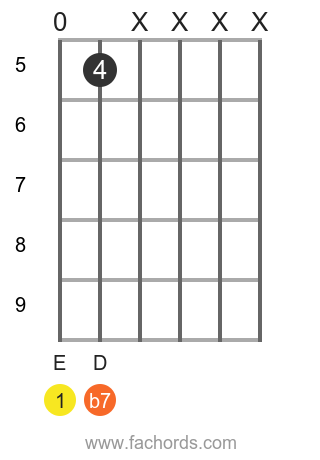
Position 2
Open
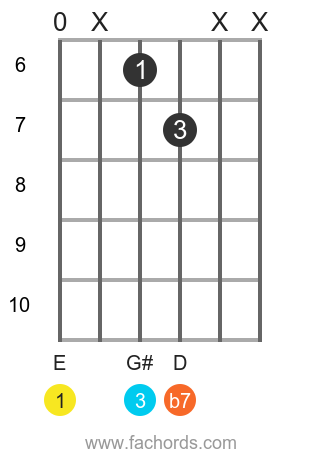
Position 3
Movable
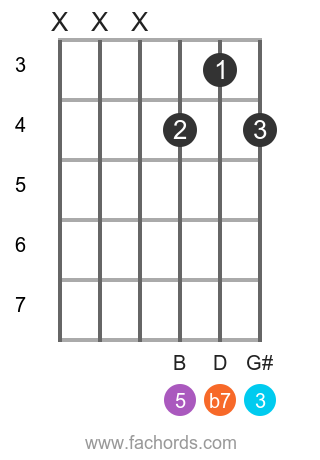
Position 4
Movable
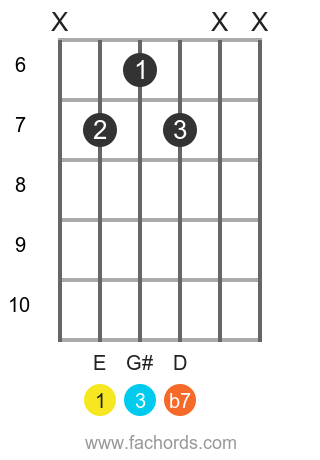
Position 5
Open
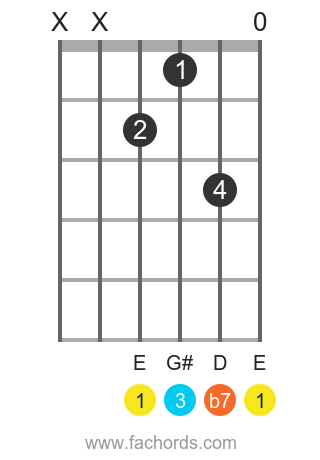
Position 6
Open
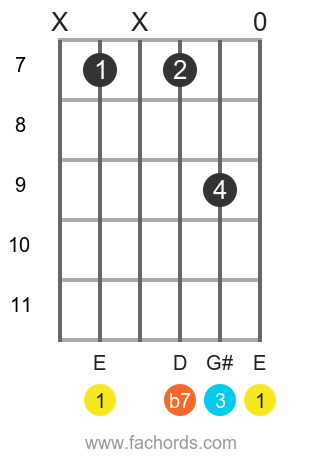
Position 7
Open

Position 8
Movable

Position 9
Movable
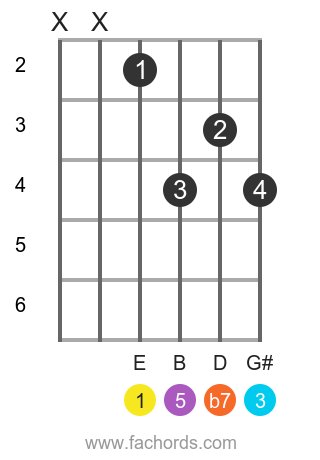
Position 10
Open
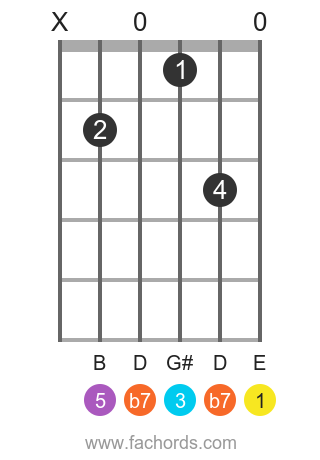
Position 11
Movable
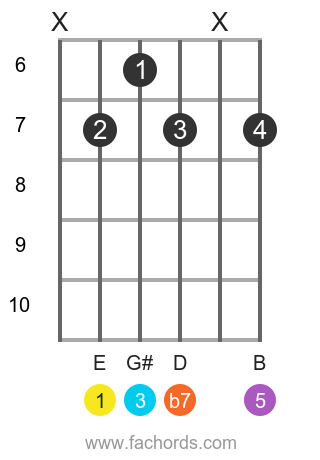
Position 12
Open

Position 13
BarreMovable

Position 14
Open
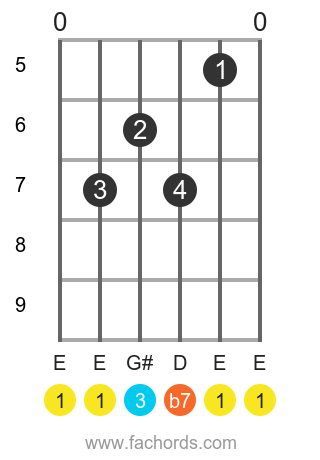
Position 15
Open
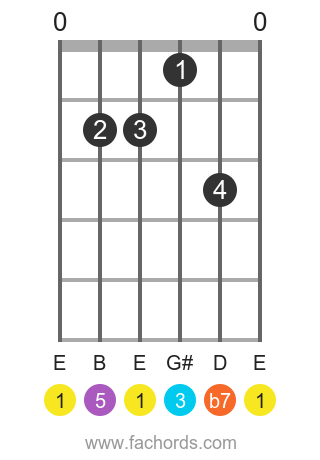
Position 16
Open
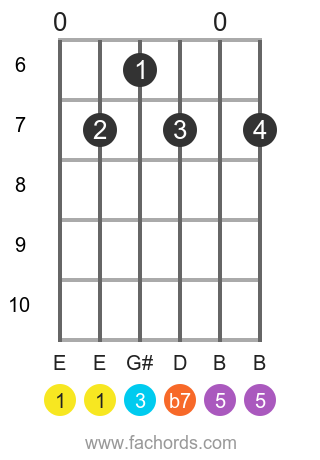
Position 17
BarreMovable
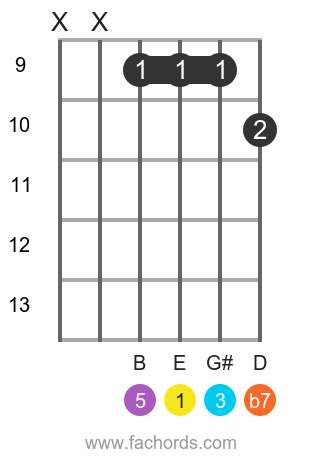
Position 18
BarreMovable
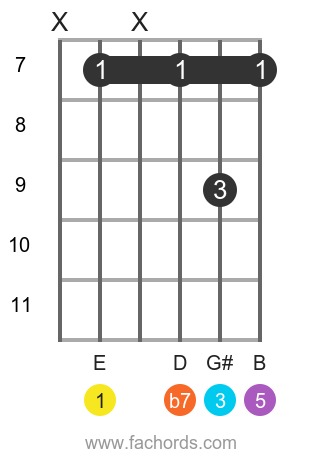
Position 19
BarreMovable
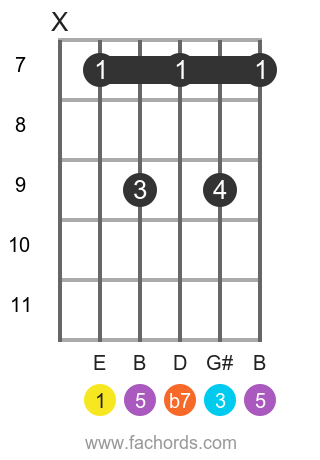
Position 20
BarreOpen
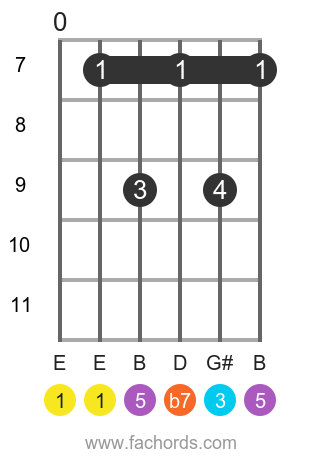
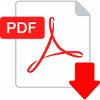 You can find more shapes in our all guitar chords online library. If you prefer a printable pdf, download
the Free Guitar Chords Chart Pdf
You can find more shapes in our all guitar chords online library. If you prefer a printable pdf, download
the Free Guitar Chords Chart Pdf
Play This Chord With Other Roots
C 7 | D 7 | E 7 | F 7 | G 7 | A 7 | B 7 | C#7 | D#7 | F#7 | G#7 | A#7 | Ab7 | Bb7 | Db7 | Eb7 | Gb7
Complete Fretboard Map of E 7 chord tones
You can create any fingering you like on any part of the fretboard, just play some of the chord tones shown in the map below. Some shapes will sound good, some less, let your ears decide!




